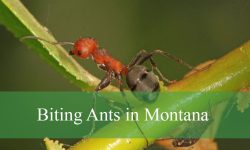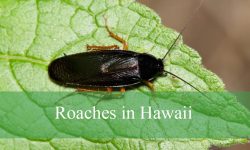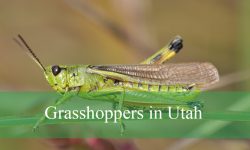The rugged beauty of West Texas is home to a surprising diversity of wildlife, especially birds that have adapted to its arid and sun-scorched landscapes. From rocky canyons to thorny scrublands, the desert terrain offers a unique environment where only the toughest species thrive. Among these are the fascinating desert birds of West Texas, each with its own adaptations and story to tell.
These birds are not only survivors but also essential parts of the desert ecosystem. Some dart across the ground in pursuit of prey, while others perch atop cacti to sing their territorial songs. Their colors, calls, and behaviors are finely tuned to life in this dry region, making the desert birds of West Texas a must-see for birdwatchers and nature lovers alike.
This guide explores 20 of the most notable desert birds of West Texas, complete with pictures and identification tips to help you recognize them in the wild. From the iconic Greater Roadrunner to the tiny Verdin, these desert dwellers reveal the rich birdlife thriving in harsh conditions.
Common Desert Birds of West Texas
Greater Roadrunner (Geococcyx californianus)
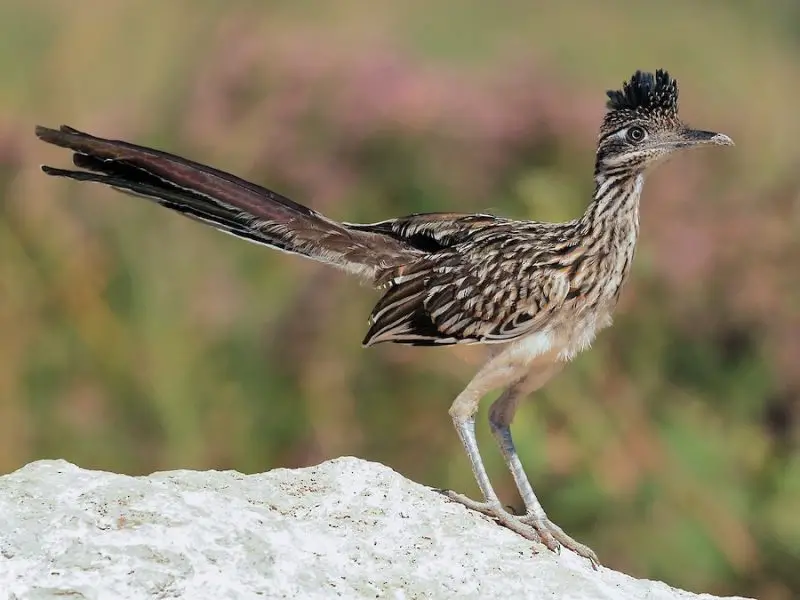
The Greater Roadrunner is a striking, ground-dwelling bird recognized by its long tail, shaggy crest, and mottled brown-and-white plumage. Its legs are strong and adapted for sprinting, with zygodactyl feet (two toes forward, two back) that leave distinctive X-shaped tracks. Measuring around 20–24 inches in length, it has a lean body and a slightly curved bill, often held forward as it dashes across the desert terrain.
This bird is famously fast, capable of running up to 20 miles per hour. It is a solitary hunter and feeds on insects, small reptiles like lizards and snakes, and even scorpions. Roadrunners use stealth and speed to ambush prey and will often pound their catch against rocks before swallowing it. While not a strong singer, it makes low cooing or clacking sounds and can emit sharp barks or growls when alarmed.
Greater Roadrunners inhabit arid lowlands, deserts, and brushy canyons throughout West Texas. They are especially common in the Big Bend region and other parts of the Chihuahuan Desert. These birds prefer open ground with scattered vegetation and are often seen on rural roadsides or basking on rocks in the early morning sun.
Cactus Wren (Campylorhynchus brunneicapillus)
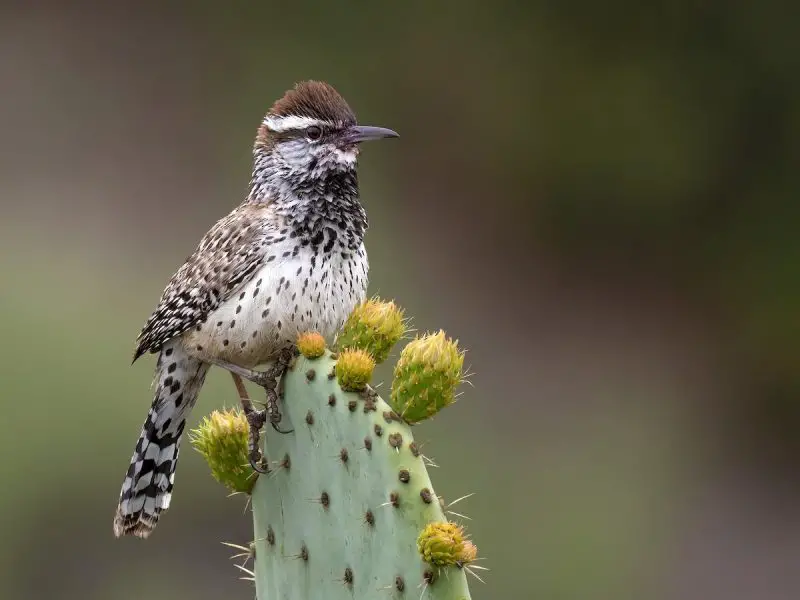
The Cactus Wren is the largest North American wren, reaching 7–9 inches in length. It has a chunky body with a boldly speckled breast, cinnamon flanks, and a prominent white stripe over each eye. Its back is barred in brown and black, and the tail is relatively long with white corners that flash in flight. The overall plumage blends well into the desert environment.
This bird is known for its harsh, grating “chaar-chaar-chaar” call, which it repeats insistently from elevated perches. Cactus Wrens are fiercely territorial and may chase away intruders, including other birds. They forage on the ground or in shrubs, flipping leaf litter to find insects, spiders, and small fruits. Unique among wrens, they construct bulky, football-shaped nests in cacti or thorny shrubs—using the spines as natural protection.
In West Texas, the Cactus Wren is a year-round resident of desert scrublands, arid foothills, and areas with abundant cholla or prickly pear. It’s frequently spotted in the Trans-Pecos region, where it thrives among thorny vegetation and dry washes. These birds are highly adapted to heat and aridity and require very little free water.
Curve-billed Thrasher (Toxostoma curvirostre)
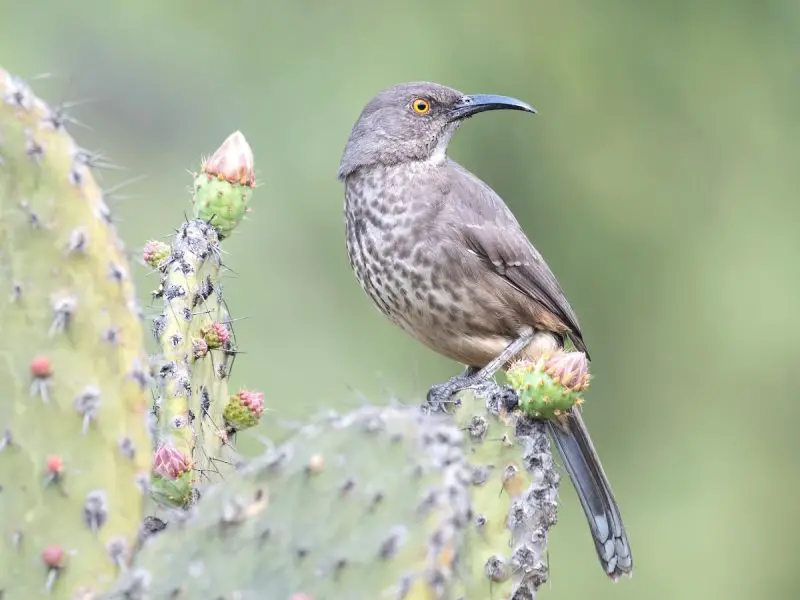
The Curve-billed Thrasher is a medium-sized songbird measuring around 10–12 inches long. Its plumage is a dusty brown-gray with faint spots on the breast, and it has a long tail and distinctively curved, black bill. Its most noticeable feature is its vivid yellow-orange eye, which gives the bird a piercing, alert expression.
Thrashers are ground foragers and often seen flicking debris or probing the soil with their long bills in search of insects, seeds, and berries. The Curve-billed Thrasher is particularly vocal, producing a loud, whistled “wit-wit-wit” song that it delivers from prominent perches. Its call is often described as musical, and males may sing year-round, especially in the early morning.
This bird is widespread across the dry brushlands and desert environments of far West Texas. It thrives in habitats with yucca, cacti, and low desert shrubs and is common around El Paso, Marfa, and the Big Bend area. The Curve-billed Thrasher is also a frequent visitor to desert gardens and feeders that offer native plants and water.
Scaled Quail (Callipepla squamata)
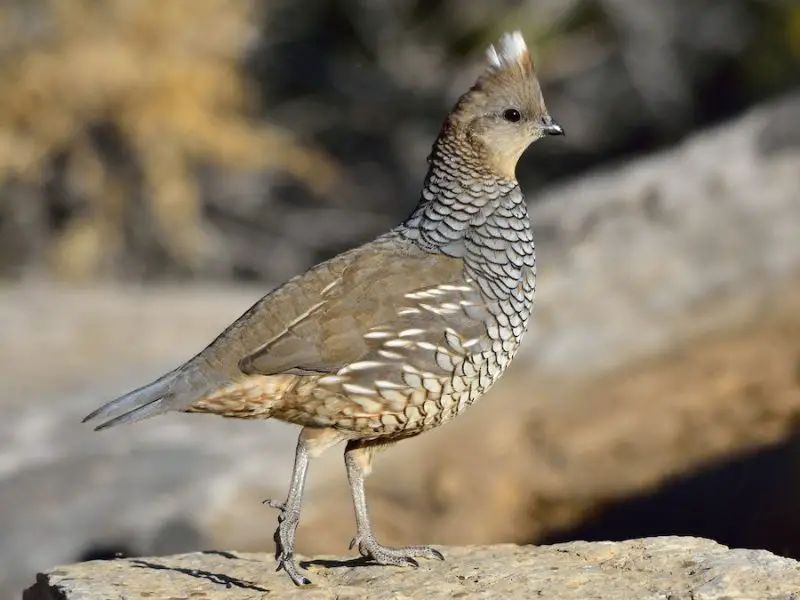
Scaled Quail, also known as “blue quail,” are ground-dwelling game birds roughly 10–12 inches in length. They have a chunky build with short wings and a short tail, and their name comes from the scaled, overlapping pattern on their bluish-gray chest and belly. A prominent white-tipped crest curls forward over the forehead, giving them a distinctive profile.
These quail live in coveys, which are groups of up to 30 birds that stay together outside the breeding season. They are known for their swift running ability and will flee on foot before taking flight. When startled, they burst into short, noisy flights. Their calls include a soft “chip-chip” as contact sounds and a sharp “quee-ark” used for alerting the group. Scaled Quail primarily feed on seeds, grasses, and insects.
In West Texas, Scaled Quail are most common in open desert grasslands, semi-arid prairies, and areas with scattered mesquite and cactus. Look for them in the Permian Basin and Trans-Pecos regions, often along dirt roads or at the edges of agricultural lands. They favor habitat with a mix of low cover for nesting and open ground for foraging.
Verdin (Auriparus flaviceps)
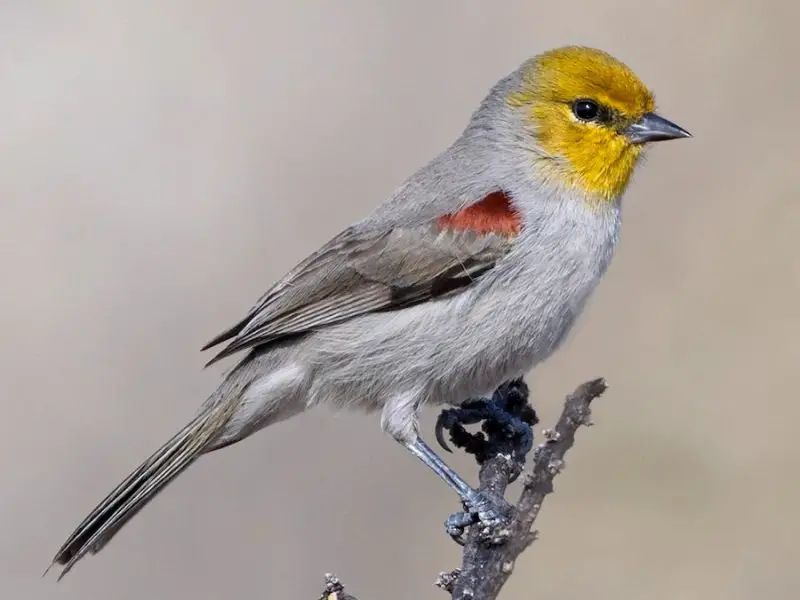
The Verdin is a tiny desert songbird, only about 4.5 inches long, with a bright yellow face and grayish-white body. Its wings and back have a soft bluish-gray tone, and it has a small, sharply pointed bill suited for picking insects from leaves and twigs. Juveniles are plainer and lack the vivid yellow head until they mature.
This energetic bird flits quickly through thorny shrubs and dry brush, often hanging upside-down like a chickadee to reach hidden insects. Verdins are known for their remarkable nest-building behavior. They construct spherical nests from twigs and plant fibers, using them for both breeding and roosting. Each bird may build several nests per year, often choosing thorny vegetation such as mesquite, acacia, or ocotillo.
In West Texas, Verdins are found in the lower elevations of the Chihuahuan Desert, especially in the Rio Grande Valley and nearby desert scrublands. They thrive in dry washes, desert flats, and areas with scattered thorny vegetation. Though small, their persistent presence and cheerful chirping make them a familiar sight in the desert landscape.
Pyrrhuloxia (Cardinalis sinuatus)
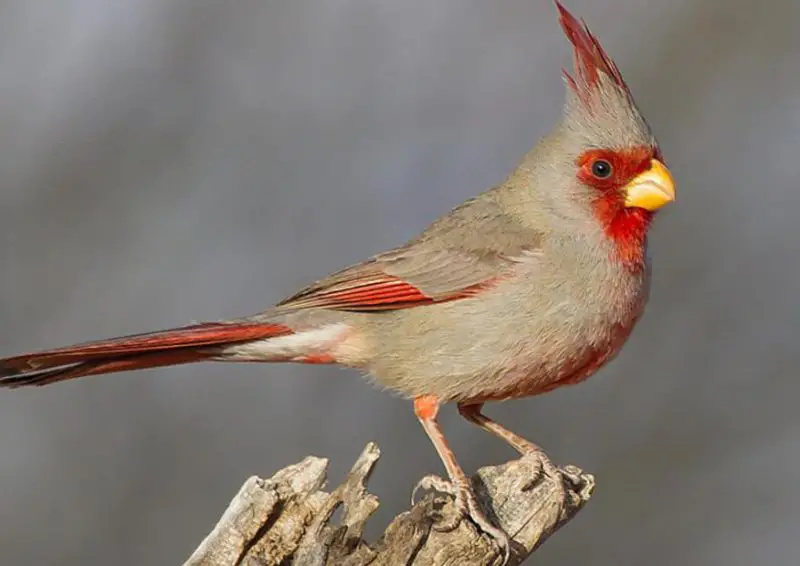
The Pyrrhuloxia, often called the “desert cardinal,” is a close relative of the Northern Cardinal but features more subtle gray plumage offset by red highlights on its face, chest, wings, and tail. Its most recognizable features are its bright yellow, conical beak—shaped like a parrot’s—and the bold red mask and tall crest. Adults typically measure about 8 inches long.
This bird is especially active at dawn and dusk, when it sings a series of sharp, whistled notes that resemble those of the Northern Cardinal but with a rougher tone. It feeds on seeds, fruits, and insects, relying heavily on its strong bill to crack open tough desert seeds. Pyrrhuloxias are often seen alone or in pairs during the breeding season and may form small flocks in winter.
In West Texas, Pyrrhuloxias inhabit mesquite brush, arid desert scrub, and riparian zones. They are widespread in the Chihuahuan Desert region, including the Trans-Pecos and Big Bend areas. Their ability to survive in hot, dry environments with minimal water makes them a classic symbol of the desert bird community.
Black-throated Sparrow (Amphispiza bilineata)

The Black-throated Sparrow is a sleek and elegant songbird easily recognized by its crisp black throat, white eyebrow stripe, and soft gray back. Measuring about 5.5 inches long, it has a compact body and a short, notched tail. Its clean, contrasting facial pattern gives it a sharp, alert look against the pale desert backdrop.
This sparrow is a common resident of rocky hillsides, desert grasslands, and low shrublands. It often forages on the ground, hopping among rocks or low vegetation in search of seeds and small insects. The male’s clear, tinkling song—a series of high-pitched notes—is a familiar and pleasant sound during spring and early summer mornings across dry regions.
In West Texas, Black-throated Sparrows are year-round residents, found in areas like the Davis Mountains foothills and Big Bend National Park. They prefer dry, open spaces with scattered brush and show a remarkable ability to survive on limited water by getting moisture from food.
Chihuahuan Raven (Corvus cryptoleucus)
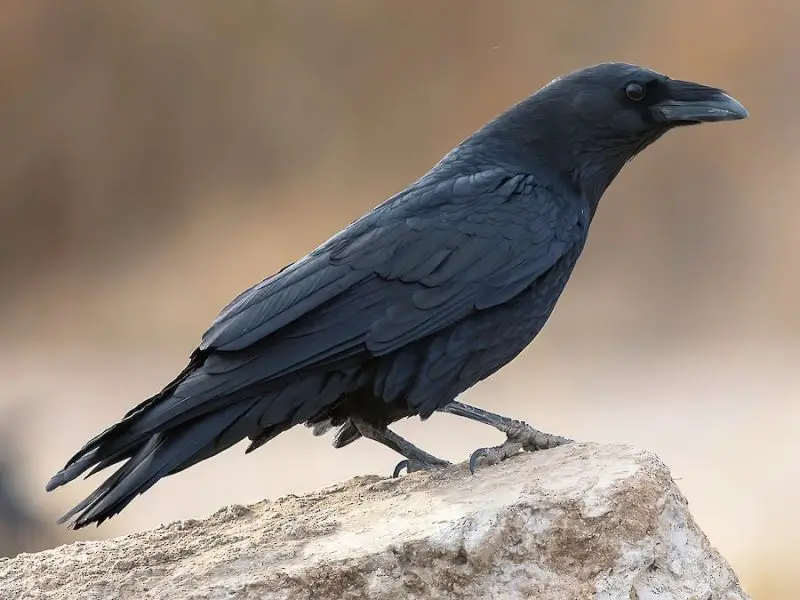
The Chihuahuan Raven is a desert-adapted member of the crow family, about 18–20 inches long with glossy black feathers and a slightly arched bill. While it looks similar to the American Crow, it has longer, pointed wings, a shorter wedge-shaped tail, and a lighter voice. One subtle but diagnostic feature is the presence of white feather bases on its body, though these are rarely visible without close inspection.
Highly intelligent and social, this raven is often seen soaring over desert scrub or perched on utility poles and fence posts. It feeds on a wide variety of foods, from carrion and insects to grains and fruits. Chihuahuan Ravens are known to scavenge and may forage cooperatively in small groups or pairs. Their calls include low, guttural croaks and sharp squawks.
This species is well-established in dry grasslands, desert plains, and arid foothills across far West Texas. It is particularly common in open areas with scattered mesquite and juniper, such as the areas around Fort Davis, Marfa, and the Big Bend region. Unlike other ravens, it rarely ventures into forested regions.
Lark Bunting (Calamospiza melanocorys)
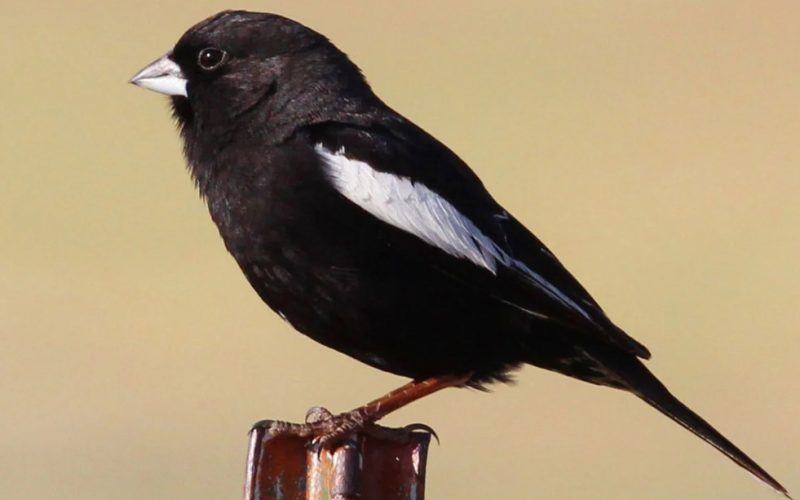
The Lark Bunting is a unique sparrow-like bird, about 5.5–7 inches long, with dramatic seasonal plumage. Males in breeding plumage are jet black with bold white wing patches, while females and nonbreeding males are a mottled brown with streaks that provide camouflage in grasslands. Their stout, pale beaks are built for eating seeds.
These birds are strong, agile flyers and often sing from low shrubs or fence wires. The male’s song includes a sweet, descending warble mixed with chirps and whistles. During courtship, males may perform fluttering flight displays. Lark Buntings forage on the ground, feeding primarily on seeds but also taking insects during the breeding season.
While their core range lies in the central Great Plains, Lark Buntings pass through West Texas during migration and may nest in semi-arid desert grasslands when conditions are suitable. They are occasionally seen in the High Plains and rolling prairie edges of the Permian Basin, especially in spring and summer.
Burrowing Owl (Athene cunicularia)
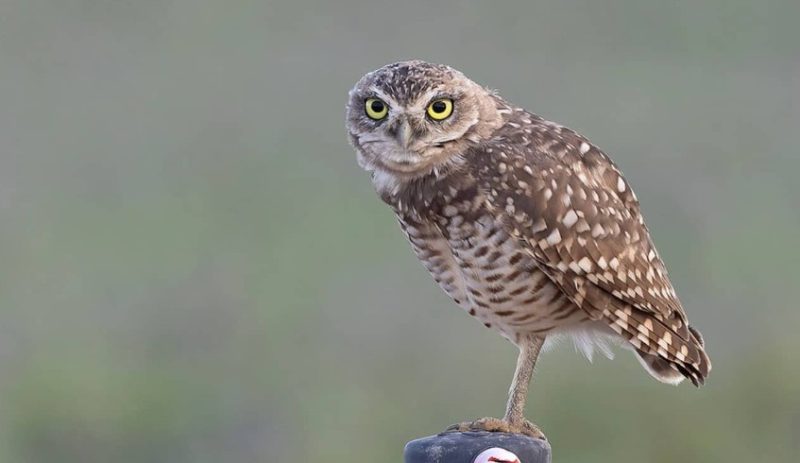
The Burrowing Owl is a small, ground-dwelling owl, measuring about 9–10 inches tall, with long legs, a round head, and no ear tufts. Its plumage is mottled brown with white spots, and it has bright yellow eyes and a white chin that accentuates its expressive face. The owl often appears alert and curious, frequently bobbing its head or staring directly at intruders.
Unusual among owls, the Burrowing Owl is active during the day, especially around dawn and dusk. It nests in burrows dug by other animals—such as prairie dogs—and lines them with grass, feathers, and sometimes even cow dung. Its call is a soft, two-note “coo-coooo” and it also makes chattering or rattling sounds when disturbed. The owl feeds on insects, small mammals, and reptiles, often catching prey on foot.
In West Texas, Burrowing Owls prefer flat, open terrain with short grass and sparse vegetation, including rangelands, desert flats, and abandoned fields. They are found in areas with prairie dog colonies or other burrowing animals, particularly in the southern High Plains and lower Trans-Pecos. These charismatic birds are a favorite among birders due to their daytime visibility and charming behavior.
Canyon Towhee (Melozone fusca)
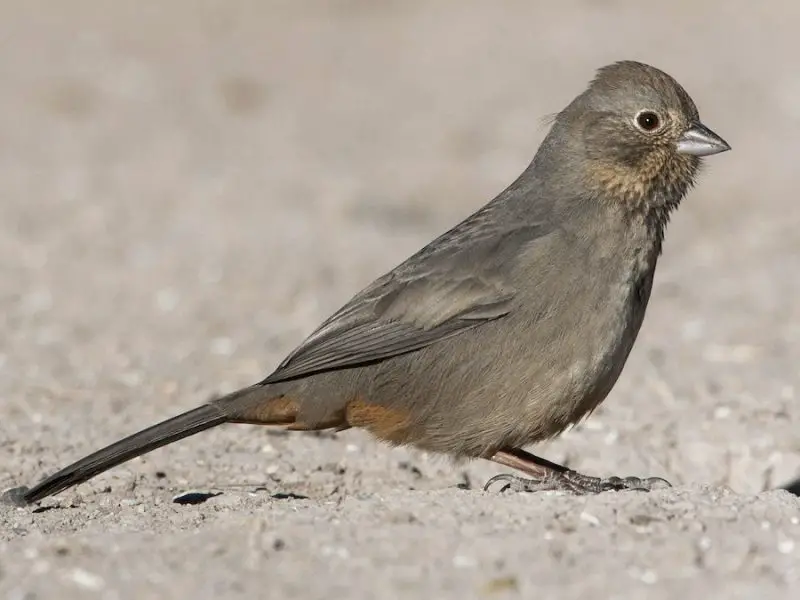
The Canyon Towhee is a modest, ground-dwelling bird with a warm brown plumage that blends seamlessly into the arid landscape. Often mistaken for sparrows, these birds are larger—about 8–9 inches long—with a plain face, faint eye ring, and a slightly rufous undertail. Their appearance is understated, but their steady presence makes them a familiar sight in the dry Southwest.
This species prefers staying close to the ground, foraging beneath shrubs, rocks, or along dusty trails for insects, seeds, and fallen berries. Canyon Towhees are known for their gentle demeanor and soft “cheh-cheh” calls, which they emit while moving through low cover. They often forage alone or in pairs, kicking leaf litter aside to expose food beneath.
In West Texas, Canyon Towhees are common in rocky desert foothills, mesquite scrublands, and canyon edges. They are year-round residents in places like Big Bend National Park, Guadalupe Mountains, and other brushy, dry regions where cover is sparse and the ground is open for foraging.
Ash-throated Flycatcher (Myiarchus cinerascens)
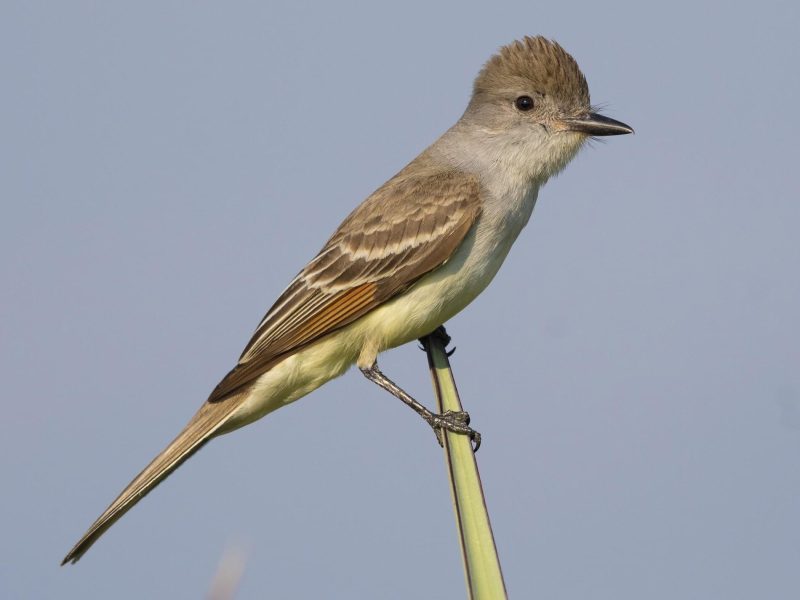
The Ash-throated Flycatcher is a mid-sized flycatcher, about 8 inches long, with soft gray on the throat and upper chest, pale yellow belly, rufous wing edges, and a modest crest. Though similar to other Myiarchus flycatchers, this species is distinguishable by its paler throat and quieter call notes.
Ash-throated Flycatchers are cavity nesters and will readily use natural tree holes or artificial nest boxes in desert regions. Their call is a distinctive, dry “kabrick” or “prrt,” often heard echoing across canyons or dry washes. They perch in open view, flying out to snatch insects mid-air before returning to a perch, typically atop a shrub or fence post.
In West Texas, this species is commonly found in desert scrub, thorny brushlands, and rocky slopes with scattered vegetation. They are particularly active during spring and summer, when their vocalizations carry through arid canyons and they begin nesting in both natural and man-made cavities.
Eastern Meadowlark (Sturnella magna)
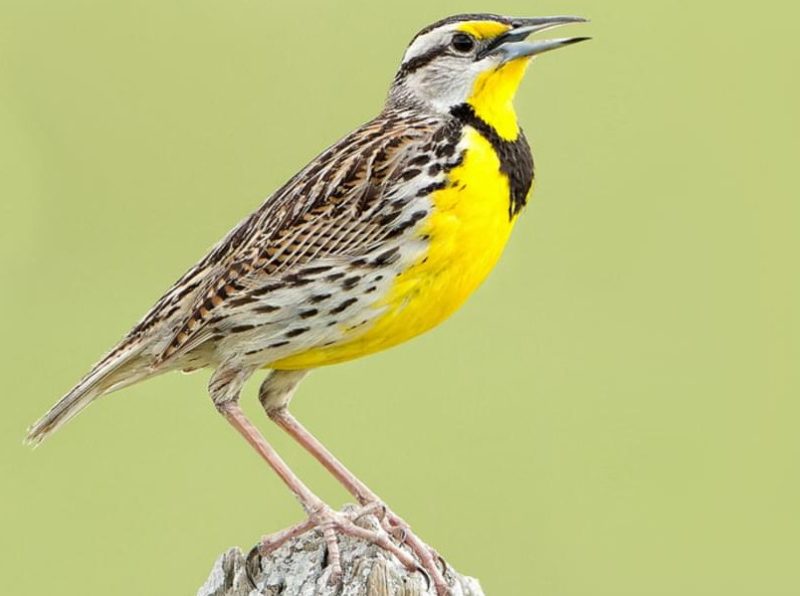
Though typically associated with moist grasslands and prairies, the Eastern Meadowlark also appears in transitional arid habitats in West Texas, particularly in semi-desert grasslands. This bird is about 9.5 inches long, with a bright yellow breast crossed by a bold black V, and a streaked brown back that provides excellent camouflage in tall grasses.
Its flute-like song is a hallmark of open country, often heard before the bird is seen. Eastern Meadowlarks forage on the ground for insects and seeds, and they may perch on fence posts to deliver their musical calls, especially during the breeding season. Their nests are well-hidden in the grass and are often domed with an entrance tunnel.
In the western parts of Texas, especially where grassy plains meet desert scrub, Eastern Meadowlarks can be seen and heard during spring and summer. They are often found near agricultural fields, roadside grassy margins, and in areas of shortgrass prairie with scattered shrubs.
Say’s Phoebe (Sayornis saya)
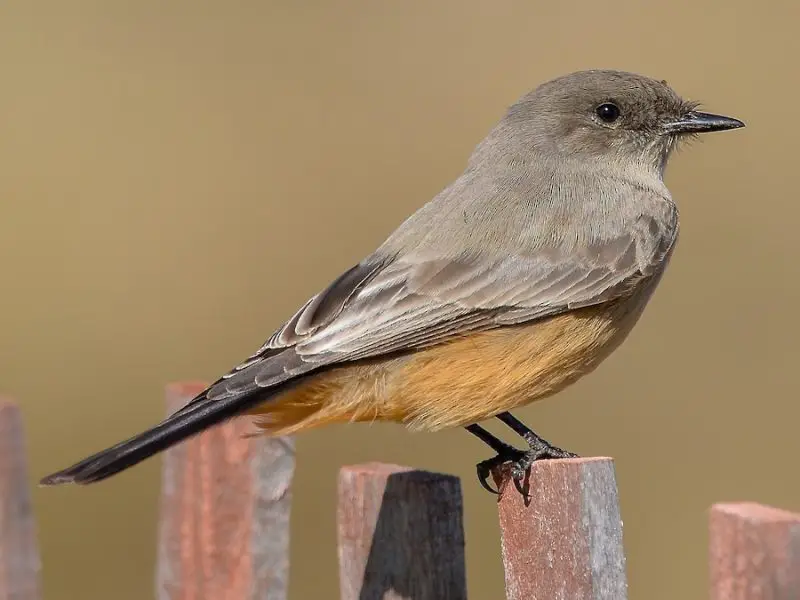
Say’s Phoebe is a graceful flycatcher well-suited to dry environments. About 7 inches in length, it has a soft gray head and back, warm cinnamon-colored belly, and a black tail. Its gentle coloration helps it blend into the muted tones of arid landscapes. Unlike more colorful relatives, Say’s Phoebe relies on subtlety and movement to attract attention.
These birds often perch on fences, rocks, or the edges of old buildings, waiting patiently to dart out and snatch insects in flight. Their call is a sharp, descending whistle or a soft, chattering trill. They may be seen wagging their tails slightly while perched, a behavior that helps in identification. Say’s Phoebes often nest under eaves, bridges, or abandoned structures.
In West Texas, Say’s Phoebes are common in dry grasslands, abandoned farmsteads, and desert plains with scattered perches. They are particularly visible during spring and fall migration but may remain to breed in the right conditions, especially near human-made structures in remote areas.
Western Kingbird (Tyrannus verticalis)
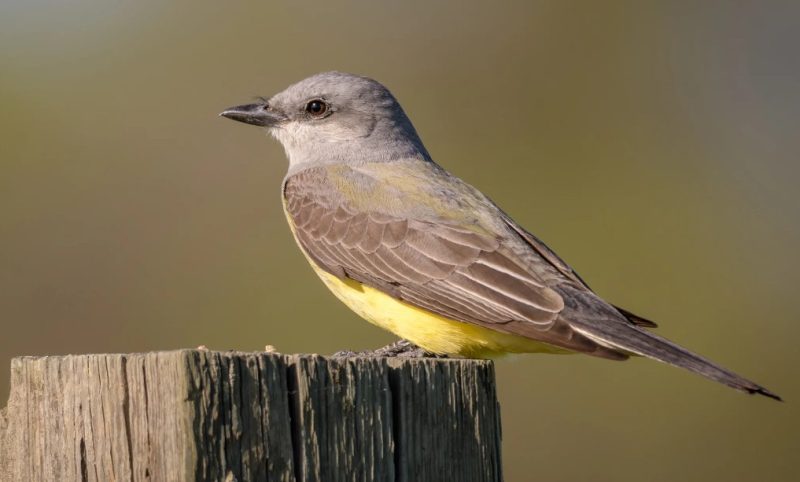
The Western Kingbird is a bold and energetic flycatcher, about 8–9 inches long, with a pale gray head and chest, bright yellow belly, and a dark tail edged in white. Its posture is upright and alert, and its behaviors are equally assertive—this bird is known for chasing off much larger intruders, including hawks and crows.
Western Kingbirds are highly visible during the breeding season, often seen perching on utility lines, fences, or shrubs in open terrain. They make frequent aerial sallies to catch insects and return to the same perch repeatedly. Their calls include sharp “kip-kip” notes and chattering bursts, especially during territorial disputes.
This species thrives in the open, sun-drenched landscapes of West Texas, from desert ranchlands to roadside corridors and agricultural edges. It nests in trees, shrubs, or even utility poles and is a common summer resident throughout the region, particularly where fields meet desert brush.
Ladder-backed Woodpecker (Dryobates scalaris)
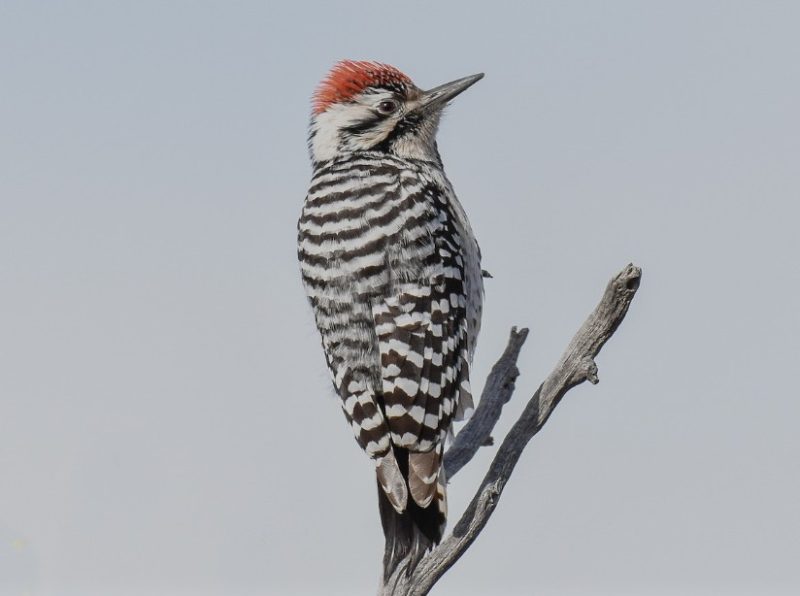
The Ladder-backed Woodpecker is a small desert-dwelling woodpecker, about 6.5–7 inches long, known for its distinct black-and-white barred back that resembles a ladder. Males have a red crown patch, while females lack the red but share the same bold, striped appearance. Their underparts are pale with faint spotting or streaking.
Unlike their forest relatives, Ladder-backed Woodpeckers are well-adapted to arid environments. They forage by tapping and pecking on soft wood or yucca stalks, probing for insects and larvae beneath bark or within pithy stems. Their calls are sharp, squeaky notes, and their drumming is fast but relatively soft. Nesting usually takes place in cavities they excavate in dead limbs of desert shrubs or soft-wooded trees.
In West Texas, they inhabit thorny desert brush, yucca stands, and areas with mesquite, ocotillo, or cholla cactus. These woodpeckers are year-round residents in the Trans-Pecos and desert foothills, particularly in places where soft, decaying wood is available for nesting.
Lucy’s Warbler (Leiothlypis luciae)
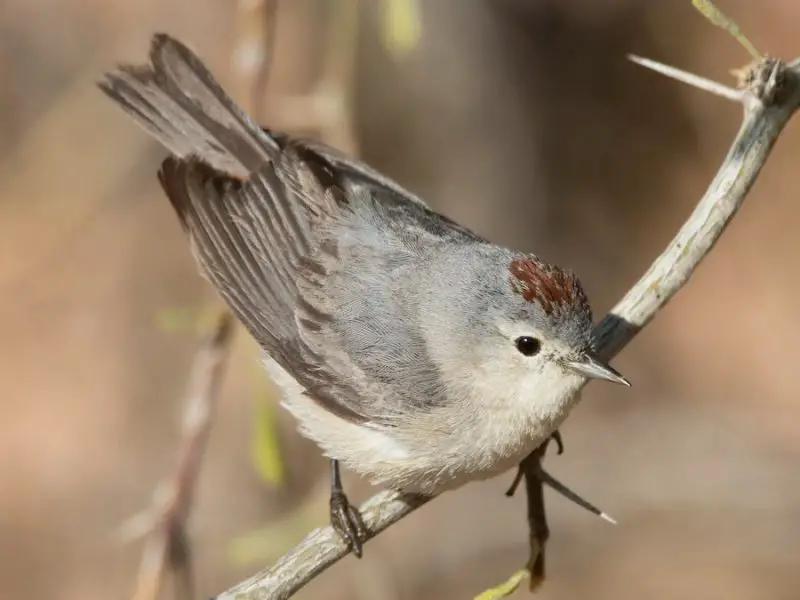
Lucy’s Warbler is one of the few warblers to breed in desert environments, measuring just 4.25 inches long. It is pale gray overall with a subtle orange or rust-colored patch on the crown and sometimes on the rump, which can be hard to see unless the bird is in motion. It has a thin, sharp bill and a slender profile typical of warblers.
This bird nests in cavities—rare among warblers—often using natural holes in trees like mesquite or palo verde, or even old woodpecker nests and man-made nest boxes. Its song is a rapid, sweet trill, repeated in short bursts from treetops or shrubs. Lucy’s Warbler primarily feeds on small insects and is most active in the morning.
In West Texas, Lucy’s Warbler is most often found in riparian desert areas and mesquite bosque habitats, especially near the Rio Grande. It is a summer visitor to the region, arriving in spring to breed and departing by early fall. Its presence is a treat for birders, as it’s one of the few warblers truly at home in desert settings.
Northern Mockingbird (Mimus polyglottos)
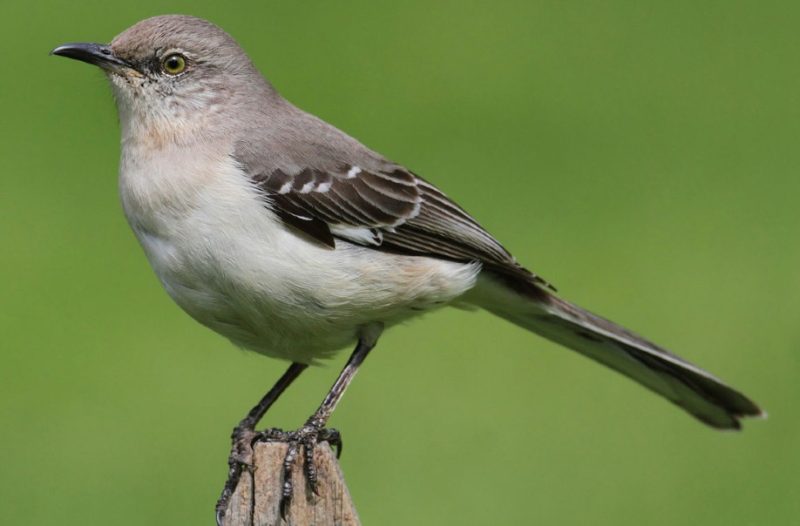
The Northern Mockingbird is a familiar and highly vocal bird found throughout Texas, including the dry desert regions of the west. About 9–10 inches long, it has a sleek gray body, white wing patches visible in flight, and a long tail edged in white. Its appearance is simple, but its behaviors are anything but.
Famed for its ability to mimic the songs and calls of dozens of other bird species—as well as mechanical noises—this bird often sings loudly and persistently, even at night. It is highly territorial and will aggressively defend its nest, sometimes swooping at larger animals or humans who venture too close. Mockingbirds feed on insects, fruits, and berries and are often seen foraging on lawns or perching on fences and shrubs.
In West Texas, they’re found in urban areas, scrubby desert habitat, and even near water sources in otherwise dry regions. Their adaptability to both natural and developed environments makes them one of the most successful birds across the state.
Bendire’s Thrasher (Toxostoma bendirei)
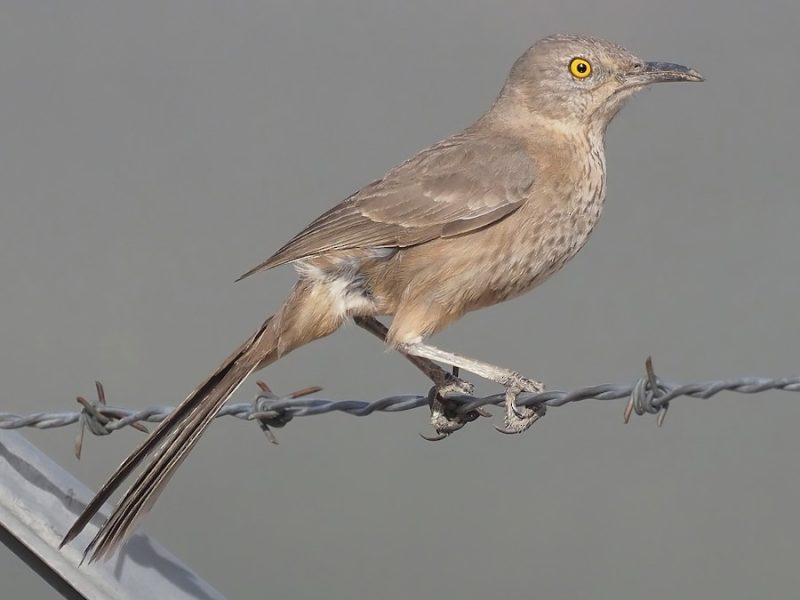
Bendire’s Thrasher is a lesser-known cousin of the Curve-billed Thrasher, with a paler, sandy-brown body and a shorter, slightly curved bill. It measures about 9.5–10 inches long and has faint spotting on the chest and a yellow eye, similar to its more common relative but with subtler markings and a gentler expression.
This thrasher has a melodious, varied song and is often heard before it is seen, especially in spring. It feeds mainly on insects, seeds, and small fruits, foraging on the ground in open desert flats. Bendire’s Thrasher is more secretive than other thrashers and prefers lower, less densely vegetated areas, making it more difficult to spot.
In West Texas, it inhabits dry shrublands and creosote flats, but its population is limited and scattered. Habitat loss due to land development and changes in desert plant communities pose ongoing threats. Conservation efforts are important for maintaining the remaining breeding populations across its limited range in far West Texas and southern New Mexico.
FAQ about Desert Birds of West Texas
What are desert birds and how are they different from other birds?
Desert birds are species that have adapted to survive in arid environments with extreme heat, scarce water, and minimal vegetation. They differ from birds in other ecosystems through their unique behaviors, such as being active during cooler times of day, and through physical traits that help them conserve moisture and find food in dry landscapes.
What are the most common desert birds in West Texas?
Some of the most common desert birds in West Texas include the Greater Roadrunner, Cactus Wren, Curve-billed Thrasher, Scaled Quail, and Verdin. These birds are well adapted to desert life, with many feeding on insects, seeds, or small animals, and nesting in thorny shrubs or rocky outcrops.
When is the best time to observe desert birds in West Texas?
The best time to observe desert birds in West Texas is early in the morning or late in the afternoon. During these cooler hours, birds are more active and vocal. Spring and fall migrations also bring more activity and a wider variety of species.
Where should I go birdwatching in West Texas?
Great places for birdwatching in West Texas include Big Bend National Park, Davis Mountains State Park, the Chihuahuan Desert, and the Rio Grande Valley. These areas offer a mix of desert scrub, rocky canyons, and riparian zones that attract a wide variety of bird species.
What kind of food do desert birds eat?
Desert birds feed on a variety of food sources depending on the species. Many eat insects, seeds, berries, or small reptiles. Birds like the roadrunner may hunt lizards or snakes, while others, such as the Black-throated Sparrow, forage for seeds and bugs among dry grasses.
How do desert birds survive without much water?
Desert birds have developed several strategies to survive with little water. They get moisture from their food, reduce water loss through efficient metabolism, and are most active during cooler parts of the day. Some species may never drink standing water at all.
Are there any endangered desert birds in West Texas?
Yes, a few desert birds in West Texas are considered at risk due to habitat loss and other environmental pressures. Bendire’s Thrasher, for example, has a limited range and declining population. Conservation efforts focus on preserving natural habitats like desert scrub and mesquite thickets.
Can desert birds be found near urban areas in West Texas?
Many desert birds can be found near towns and cities in West Texas, especially in areas with native plants and open spaces. Species such as the Northern Mockingbird, Curve-billed Thrasher, and Say’s Phoebe are often seen on fences, rooftops, or in desert-themed gardens.
Do desert birds migrate?
Some desert birds are year-round residents, like the Cactus Wren and Ladder-backed Woodpecker, while others migrate seasonally. For example, Lucy’s Warbler is a summer visitor to West Texas and migrates south for the winter. Migration patterns depend on food availability and climate.
How can I attract desert birds to my property in West Texas?
You can attract desert birds by planting native desert shrubs such as mesquite, acacia, or yucca, providing water sources like shallow birdbaths, and avoiding pesticides. Adding nesting boxes and keeping a natural, brushy landscape also makes your property more inviting to birds.

